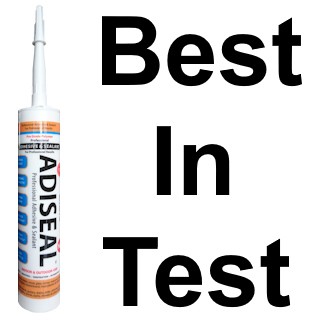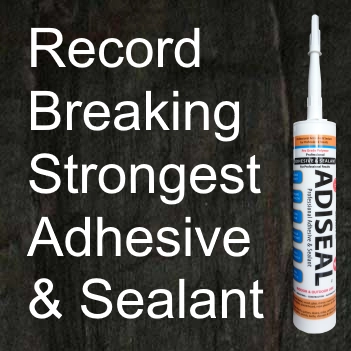Outdoor Sealant
Outdoor Sealant Adhesive: Exterior Weatherproof Sealing
Adiseal outdoor sealant provides a high-performance waterproof seal in both interior and external sealing applications. It can seal instantly in dry, damp or wet conditions. Adiseal exterior weatherproof sealant is ideal for both emergency repairs as well as long term sealing. The outdoor waterproof sealant can withstand harsh weather conditions and is also an outdoor adhesive at the same time, making it ideal at also sticking items outside as well as sealing.
- What is the importance of using outdoor sealants
- How to apply outdoor sealants
- Where to buy outdoor sealant

What is the importance of using outdoor sealants
Using outdoor sealants to protect from water damage is crucial because outdoor areas are constantly exposed to the elements, making them vulnerable to damage. An exterior waterproof sealant can create a waterproof barrier that prevents water from infiltrating cracks and joints. By using a waterproof exterior sealant, property owners can protect their structures, prolong their lifespan, and reduce the need for costly repairs from water damage.

Durability and Weather Resistance
Adiseal excels in durability and weather resistance, outperforming competitor sealants. Its advanced formula provides a high-performance weatherproof seal, resists UV rays, temperature fluctuations, and other environmental challenges.
Versatility for All Outdoor and Exterior Applications
Adiseal is a versatile sealant suitable at sealing outdoors and indoors. Whether it’s sealing gaps in decks, roofs, gutters or other exterior application, Adiseal handles each project effortlessly. Its compatibility with different materials include wood, metal, concrete, plastic, stone and many other materials outdoors.
Easy Application and Long-Lasting Results
Adiseal’s user-friendly application is favored by both DIY enthusiasts and professionals for good reason. Its smooth consistency and easy handling make for a seamless, professional finish. Plus, its outstanding adhesive strength and flexibility ensure a long-lasting seal that stays effective for years, eliminating the need for frequent reapplications and offering lasting peace of mind.
Protection Against Water Infiltration:
Adiseal’s waterproof sealing properties prevent water damage like rot or structural issues in outdoor projects. By forming a watertight barrier, it secures the integrity of exterior applications, saving you time and money on repairs. Instant sealing of leaks also shows Adiseal’s immediate effectiveness in creating a waterproof barrier.
Proven Performance and Trustworthy Reputation:
Adiseal’s reputation as the best outdoor and exterior sealant is backed by proven performance and the trust of countless satisfied users. With its impressive track record and positive reviews, Adiseal has become the go-to choice for those seeking reliable and long-lasting sealing solutions.
Benefits of Adiseal Outdoor Sealant & Adhesive
- Works in dry, wet, even underwater
- Good initial grab (for even more grab, use Adiseal Hi-Grab)
- Gap filler adhesive
- Resists mould
- Over paintable (paint can be mixed into Adiseal Ultra Clear to make custom coloured sealant)
- Non brittle (stays flexible)
- UV resistant
- Waterproof adhesive
- Waterproof sealant
- Virtually odourless (no harsh solvent smell)
- Isocyanate free
- Solvent free (safe for use on sensitive materials)
- No shrinkage or cracking
- Flexible adhesive and flexible sealant
- Prevent fungal growth
- Prevent bacteria growth
- Good resistance to chemicals
- EC1 Plus certified (No VOC)
- ISEGA certified – safe for use in food preparation areas
- Suitable for internal & external use. Also great as an exterior grab adhesive.
How to apply outdoor sealants
Applying outdoor sealants requires careful attention to detail and proper technique to ensure a secure and effective seal. Here are some general steps to follow when applying outdoor sealants:
How to apply outdoor sealants
- Surface Preparation
Thoroughly clean the surfaces to be sealed, removing any dirt, debris, grease, or old sealant. Use appropriate cleaning agents and tools, such as a wire brush or sandpaper, to ensure a clean and smooth surface.
- Masking
Use masking tape or painter’s tape to protect adjacent surfaces or areas that should not come into contact with the sealant. This helps achieve clean lines and prevents unintentional spread of the sealant.
- Cut the Nozzle
Cut the nozzle ensuring an appropriate-sized opening for the desired bead size.
- Apply the Sealant
Apply steady pressure to the trigger or plunger. Start at one end of the intended sealing area and move along, ensuring a consistent and even bead of sealant.
- Tooling
After applying the sealant, use a tool like a caulking gun or a specialized tool (e.g., a caulking tool or a putty knife) to smooth and shape the sealant.
- Remove Excess Sealant
Remove excess sealant. This helps maintain clean lines and prevents unsightly buildup
- Curing Time
Allow the sealant to cure according to the manufacturer’s instructions. Avoid any contact or disturbance during this period to ensure proper bonding and effectiveness.
Tip: To store Adiseal once opened, leave about 1cm worth of product out of the nozzle and store the tube upright in a cool dry place. Adiseal requires moisture for it to cure. The exposed part out of the nozzle will cure creating a cap. To re-use Adiseal, pull the cured part out or cut the nozzle until the uncured part is reached.
Colours
Adiseal adhesive and sealant is available in the following colours:
- White adhesive and white sealant
- Black adhesive and black sealant
- Grey adhesive and grey sealant
- Clear adhesive and clear sealant
- Brown adhesive and brown sealant
Adiseal can also be manufactured in any RAL colour.
Where to buy outdoor sealant
To buy outdoor sealant in the UK, please contact us for details of your local stockist. For other countries that do not have a Adiseal distributor, you can buy from www.guglue.com
Frequently asked questions about outdoor sealant
Outdoor sealants are used to create a protective barrier against moisture, UV rays, temperature changes, and other environmental factors. They prevent water infiltration, maintain structural integrity, and prolong the lifespan of outdoor surfaces and structures.
Outdoor sealants endure harsh conditions like sunlight, rain, and temperature changes, so choosing the right one matters. Adiseal stands out as a versatile option, excelling in both indoor and outdoor applications, ensuring durable and reliable performance.
Yes, many outdoor sealants can be painted over once they have cured. However, it’s important to follow the manufacturer’s guidelines and ensure that the sealant is fully cured before applying paint. Some sealants may require priming or specific types of paint for optimal adhesion and compatibility.
The environmental friendliness of sealants can vary depending on the brand and formulation. Many manufacturers are now producing sealants with low VOC (Volatile Organic Compounds) content and eco-friendly ingredients. Seek sealants labeled as environmentally friendly or low VOC to reduce the impact on air quality and the environment.
The lifespan of an outdoor sealant depends on factors like the type of sealant, application, and exposure to the elements. High-quality outdoor sealants, like Adiseal, can offer long-lasting protection for many years or more when applied and maintained correctly.
Adiseal outdoor sealant provides a high-performance waterproof seal that has high weather resistance. It can seal instantly in dry, damp or wet conditions.
Adiseal provides a strong waterproof seal in external sealing applications. Adiseal is weatherproof, UV resistant, flexible and durable making it withstand harsh weather conditions outdoors.
Silicone sealant is not suitable for use in the rain as it requires a dry surface to apply it to. Adiseal outdoor sealant can be applied in the rain and will seal instantly, even in wet conditions.
Adiseal sealant is the best sealant to use in wet conditions. Unlike silicone sealant that can not be applied to wet surfaces, Adiseal sealant can be applied on dry or wet surfaces. It seals instantly and provides a highly durable waterproof seal.
Adiseal sealant adhesive is great for outdoor use as well as indoor use. It can be applied to dry or wet surfaces and can seal instantly even in wet conditions like rain. It remains waterproof, flexible, UV resistant and highly durable.
